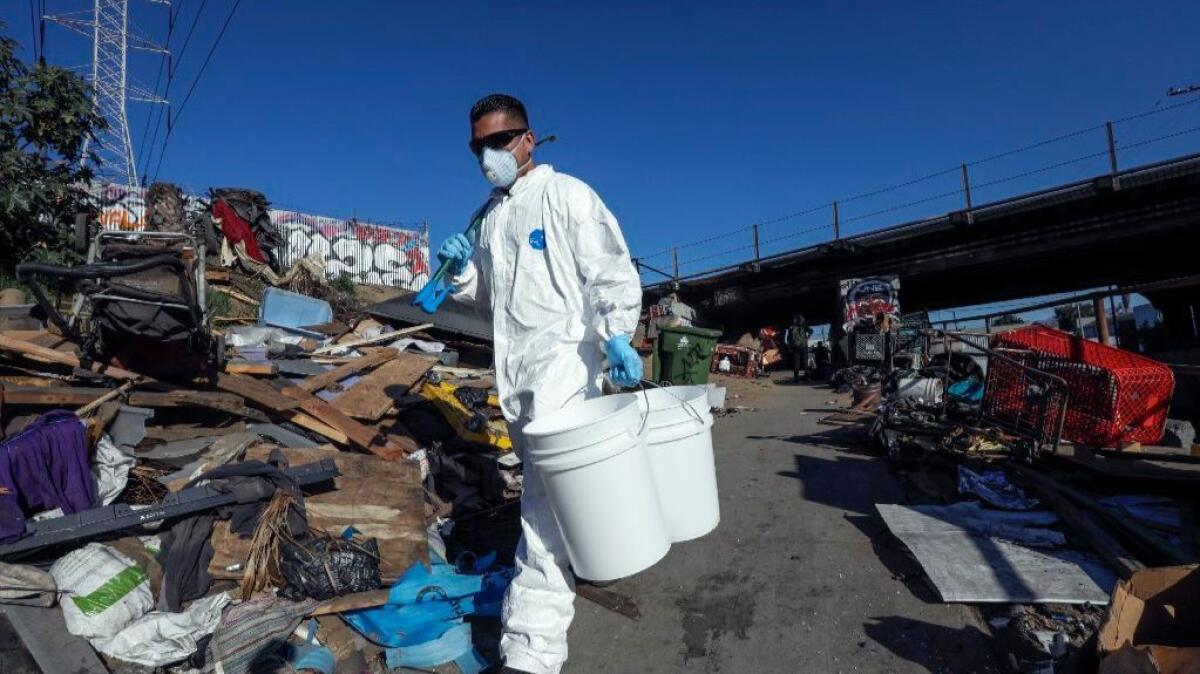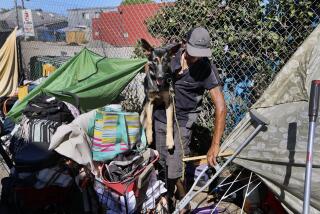L.A. wants more money for homeless encampment sweeps

- Share via
The city of Los Angeles has a mounting backlog of requests from the public to clean homeless encampments, prompting the city’s Bureau of Sanitation to seek millions of dollars more to pay for the sweeps.
Clean Streets Los Angeles, a program started by Mayor Eric Garcetti, has nearly 6,000 requests pending to clean encampments citywide, according to data through early February.
Because there can be multiple calls to clean up the same site, officials say there are far fewer than 6,000 encampments. Also, some of the requests may be closed if a preliminary visit shows no sign of a camp.
A Bureau of Sanitation report on the backlog released last week cites a rising homeless population and an informed public that increasingly knows how to call for cleanups. The city gets about 1,900 requests a month for cleanups, a nearly threefold increase over two years ago, according to the report.
The freeway corridors around Hollywood and downtown have some of the highest concentration of tents and shanties, according to the report, which will be discussed Wednesday at a City Council committee hearing.
Grappling with the backlog, as well as the overall rise in homelessness, the Bureau of Sanitation will seek $17 million — more than double the amount budgeted this year — for the Clean Streets program for the fiscal year starting in July, said Lisa Mowery, the bureau’s chief financial officer.
Garcetti spokeswoman Anna Bahr said the mayor supports increased funding for encampment cleanups and other homelessness outreach efforts.
“The current demand for encampment cleanups is outpacing the city’s ability to service them,” Bahr said.
The backlog highlights the city’s challenge in responding to residents and businesses who complain about the human waste, drug use and disorder at the camps.
Clean Streets received $5.4 million last fiscal year and $6.4 million this year.
The cleanups are controversial, with homeless people complaining that their belongings have been taken away. Officials say the sweeps are necessary to protect against diseases, including hepatitis A, and keep public walkways clear.
Others have questioned spending millions of dollars on what is essentially an outdoor cleaning service. Officials acknowledge that many homeless people return to the same site hours or days after a sweep.
Mark Ryavec, president of Venice Stakeholders Assn., said that city officials need to weigh the cost benefits. “What if it’s cheaper to put that money toward a hotel or motel vouchers? What’s the tipping point?” Ryavec said in an interview.
City Councilman Jose Huizar, who has more than 1,200 pending requests for cleanups in his downtown district, called the backlog a public safety issue and said he gets complaints that it takes months for service.
“How can we go to our constituents and say with a straight face, ‘We will get to this’ ”? Huizar said in an interview.
At a cleanup in Boyle Heights this month, workers in protective gear picked through knee-deep piles of trash, furniture and clothing at an encampment under a railroad bridge. Bullets and hypodermic needles were found amid the debris.
The site has been cleaned three times in the last 18 months. Each encampment scheduled for a cleanup gets an average of six requests for service, said bureau spokeswoman Elena Stern.
To manage the backlog, the Bureau of Sanitation report recommends putting more crews in areas with a higher number of camps and speeding up the approval process for a cleanup.
City data through early February show 2,400 requests for homeless clean-ups that are more than 91 days old.
Most of the requests are made through the city’s 311 hotline system, which allows reports to be made by phone, website or smartphone app.
Morris Pichon, a Pacoima community activist, said he recently called about an encampment that popped up two months ago across the street from his house. Nestled near a baseball field, the camp isn’t easy to spot.
“Everyone calls,” he said. “My wife calls, my daughter calls.”
Mike O’Gara, a member of the Sun Valley Area Neighborhood Council, said the city needs to act more quickly to clear the camps.
“It takes an interminable amount of time, and while we’re waiting for the city to act, the encampment is growing,” O’Gara said.
Mowery, of the Bureau of Sanitation, said more funding will also be sought in the next budget year for other programs, including Homeless Outreach and Proactive Engagement, or HOPE, teams. Led by the LAPD, the teams offer shelter and services to camp residents.
The city is also focusing on clearing homeless encampments in the hillsides following the Skirball fire in December, which is believed to have been sparked by a cooking fire at a homeless camp in Bel-Air.
The Fire Department found evidence of 190 encampments in hillside areas, although many camps were gone when fire officials returned for a second time.
The Bureau of Sanitation will be responsible for clearing the hillside camps, Garcetti spokeswoman Bahr said.
Twitter: @dakotacdsmith
More to Read
Sign up for Essential California
The most important California stories and recommendations in your inbox every morning.
You may occasionally receive promotional content from the Los Angeles Times.









